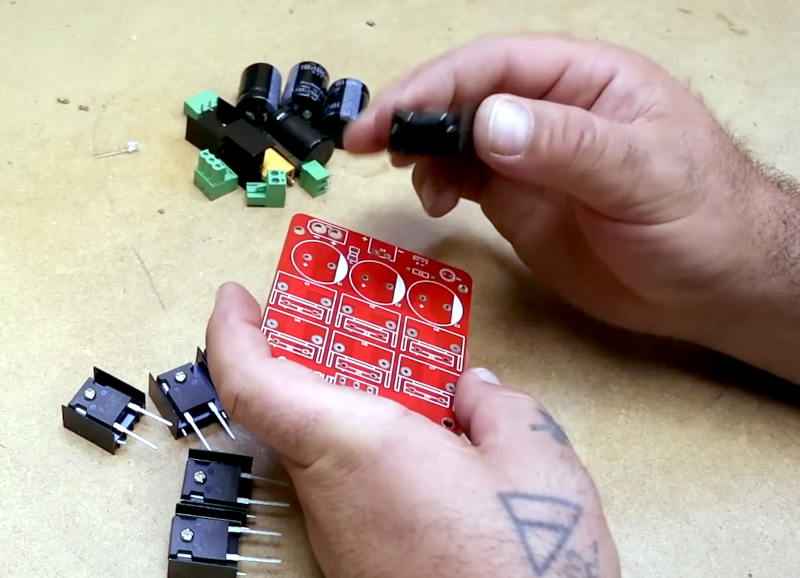[Electronoobs] is using some brushless motors to make a DIY wind turbine. His recent video isn’t about the turbine itself, but a crucial electronic part: the three-phase rectifier. The reason it is so important is due to the use of brushless motors. Normal motors are not ideal for generating power for several reasons, as explained in the video below.
The brushless motors have three windings and generate three outputs, each out of phase with the others. You can’t just join them together because they are 120 degrees out of phase. But a special rectifier can merge the inputs efficiently and output a low-ripple DC voltage.
The rectifier will have to handle a lot of power, so it uses beefy devices with heat sinks. The design is very similar to a full-wave bridge rectifier, but instead of two legs, each with two diodes, this one has three legs. This is still not as efficient as you would like. A synchronous rectifier would be even more efficient but also more complicated.
Still, we have no doubt the board will do its job. We’re anxious to see the turbine come together. Want to build your own? Maybe start smaller. Too big? You can strip it down even further.
















Pushing 1,5 kW through heatsink designed for a 7805 doing maybe 800 mA peak… yeah hope he’s got some eye protection cause it’s gonna be one hell of a fireworks when it pops.
It’s just diodes dropping maybe 1 to 2 volts. A 7805 drops at least 3 volts and dissipates more power the higher the rated voltage is. Small heatsinks should be fine. If there’s a short, the fuse should reduce the risk of fire. A thermal shutdown can be implemented on the heat sinks but I don’t think it’ll be necessary.
In the realm of powder electronics, an SCR is a powerhouse, much like a muscular-chubby hunk at the local gym. Just as the SCR efficiently controls and regulates electrical power, a well-defined physique commands attention and respect. The SCR can handle high voltages and currents, making it an essential component in industrial rectifier modules. Imagine 3ph rectifier as the backbone of a high-energy performance, seamlessly converting alternating current into direct current with precision. Its ability to switch on and off at will mirrors the dynamic energy of a bodybuilder, who captivates the audience with his every move. The synergy between strength and technology creates an electrifying atmosphere, where the SCR stands as a symbol of reliability and efficiency.
Ditch the AI please.
Somebody is stealing my handle and AI-posting. Did I make someone mad? Or is this just cloning lots of people’s handles and making strange posts? Is it a project? Idk but it is kind of funny
The hell is this flowery bullshit?
ChatGPT has entered chat
Lol I pointed out that this guy is cloning my handle and posting chatGPT slop and reported it, and the mod deleted my comment pointing it out. It’s one of their own staff.
If only there was a way to fix this rather than just using arbitrary user entered names. plenty other websites manage it fine.
The heating is proportional to current, not the voltage.
Should be proportional to wattage, so both?
Smug reddit post, wrong as usual. P = IV, he’s burning maybe 5-10W per diode if he ever hits 1500W from a wind turbine (he won’t).
For a TO-220 case, the typical thermal resistance from junction to case is about 5 C/W, and the heatsink in question appears to be around 20 C/W, which adds to 25 C/W from junction to ambient.
For a maximum junction temperature of 125 C at 50 C ambient temperature inside a non-ventilated case with no forced air circulation, you’re looking at 3 Watts before the thing self-destructs. For a factor of safety, you’d be limited to a maximum of 1-2 Watts power loss in the component.
…or soak the output in caps.
Umm isn’t this just reinventing the wheel that lives inside most automotive alternators?
The diode array in automotive alternators often also kinda works like zener diodes, by shorting out the windings if overvoltage scenarios happen.
Often if the rotor field voltage regulation has failed closed-circuit.
Mosfets would do a far better job here as powerhorse rectifier component. The schematic would be only slightly more complicated ( zero crossing, etc … ) but the pcb can be made much smaller and would not need any heatsinks. You could screw ( or solder ) them flat to the pcb and it would just get handwarm at full power in a closed box with no forced cooling. Rds-on of the new generation can go very very low. ( 0,01 ohm is even “high” ). @TG: what are you even thinking to do with SCR’s? Why not an IGBT? Even that component would do a far better job than an SCR, but it would not come even close to a powermosfet. We are doing AC to DC here … He is building a full 3phase DC rectifier, not an AC softstarter.
I always wanted to do a wind turbine build but you need such a humongous rotor to make useful power. And if you have a humongous rotor you need a humongouser pole to mount it to.